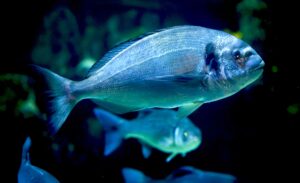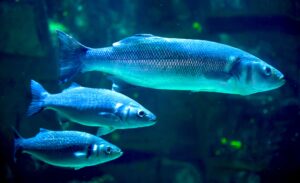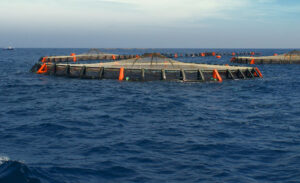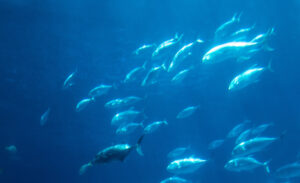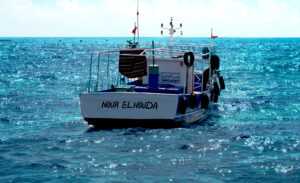Where do sea breams live?
The gilthead seabream is a typical marine fish in the Mediterranean Sea, and the eastern Atlantic Ocean, from the British Isles to the Cape Verde area off Senegal.
Gilthead seabream is a coastal species living at no more than 150 meters from the coast, and adapting to hard and sandy bottoms. The areas of most excellent density are those bordering the two seabed types.
This type of fish is a particularly euryhaline species, i.e., it can adapt to wide variations in the degree of salinity of the water. This means that the gilthead bream can be found in the sea and the brackish areas of river mouths and lagoons, partly because it does not like too cold water.
What does a sea bream look like?
The gilthead seabream owes its name to the characteristic golden band, which is found on its flattened head, together with a black band. Its length is on average between 20 and 50 cm, although it can rarely reach up to 70 cm, and 5 kg in weight.
Its body is oval and has a single blue-grey dorsal fin. Another typical feature of the gilthead bream is a brown spot on the upper part of the gill operculum.
Its sides are silver-colored, with scales interrupted at the snout, while the back is blue-grey.
The gilthead seabream has sharp teeth at the front of the jaw, and molar-shaped teeth at the back.
The life of a sea bream
The gilthead seabream lives mainly alone or in small groups, and has not developed an intensely social activity. Its average lifespan is about 20 years.
It feeds on mollusks and crustaceans, which it can crush with its strong teeth, but it also likes to feed on algae.
Sea bream reproduction
The gilthead seabream is a hermaphrodite species that first develops its male organs, and then, after two years, the female organs develop when it reaches 30/40 cm in length.
So usually, when breams are small, they are males, and when they reach a more significant size, they are females.
The breeding season is autumn and winter, usually from October to December.
Sea bream fishing
Gilthead seabream meat is highly prized for its flavor, texture, and almost complete lack of bones. Therefore, gilthead seabream is of great interest to fishermen, especially for rod-fishing, where mussels in shells or crustaceans are usually used as bait. The gilthead bream is suspicious in nature, so a very long line is needed to lure the fish. Experienced fishermen are familiar with the gilthead bream’s technique, which involves not swallowing the bait immediately, but holding it in their mouth for a while, to make sure it can be eaten. This is where the sensitivity and cunning of the fisherman come into play: he is capable to wait and recognize until he feels the right “touch”, i.e., when the fish has swallowed the bait and the hook.
The same patience and cunning must be used in spearfishing as well, to camouflage oneself, and not be spotted by the fish. Spear-fishers know that the bream is particularly vulnerable when it is feeding, and can wait in the right place, looking for the traces left by mollusk fragments left by the fish at the right time.
Those who practice these activities know that sea breams like to live in shallow waters, at a temperature of around 18°C, and perhaps near mussel farms where they can find food in large quantities.
On the other hand, net fishing techniques are practiced for commercial purposes, using the characteristics of the gilthead sea bream to select the areas of maximum catch.
Sea bream farming
For meeting the high demand from the food industry, sea breams are raised in aquaculture for greater profitability. This type of facilities differs in size and in fish population density in each particular area.
The goal is to guarantee the highest organoleptic quality of the product in relation to the greatest possible quantity the farm can handle.
The quality/quantity ratio can be managed by the level of sophistication of the farm where, on the one hand, the natural growth and feeding conditions of the species are guaranteed, and, on the other hand, these must be artificially recreated through force-feeding, water recirculation, and constant monitoring of the necessary biological conditions.
This process is called aquaculture and involves different levels of productivity.
Extensive farming is organized by delimiting a large sea area to provide natural feeding of the sea breams. In this case, the quality of the product is maximized, as there are no substantial differences between farmed and caught fish. There is no need to intervene in water quality because the basin is natural and maintains the biochemical characteristics of the surrounding environment.
Greater environmental control is needed when a marine environment is recreated in tanks with a high concentration of fish. These farms are divided into intensive and hyper-intensive aquaculture, depending on the population density in the tank.
In intensive systems, it is necessary to provide a greater quantity of food, which would otherwise not be sufficient, and to ensure a constant exchange of water capable of cleaning the waste and then filtering it so that it can be disposed of.
This happens with even greater intensity in hyper-intensive facilities, where a higher population density is confined to a tank where the biochemical conditions necessary for the development of the species must be recreated.
In these facilities, food supply, water exchange, temperature, pH level, oxygen, salinity, light, and many other factors necessary for healthy population development must be constantly monitored.
Hyper-intensive facilities use sophisticated water recirculation systems that subject the water to numerous treatments – chemical, biological, bacterial killing, and many others. These farms in particular, are equipped with bio-filters to ensure more natural environmental conditions for the fish.
The countries of the Mediterranean basin are the ones where breeding facilities for sea bream have developed the most. Greece, Turkey, Italy, Spain, Croatia, Tunisia, and Egypt are the major producing countries.
Aquaculture is a constantly evolving industry, and improvements are being tested to ensure ever-better product quality, conditioned by the ever-improving environmental conditions in which it grows.
The difference between the product caught, and the one raised in hypertensive facilities, is still perceptible. Still, researchers are working to provide an even better product in the quantities required by the market.
Improving plant waste disposal is also an evolving development field, prompted by the increasing awareness of environmental issues, even more so when related to the food industry.
